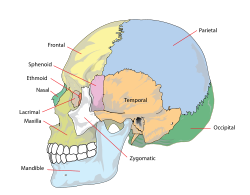Craniofacial abnormality

Editor-In-Chief: Prab R Tumpati, MD
Obesity, Sleep & Internal medicine
Founder, WikiMD Wellnesspedia &
W8MD medical weight loss NYC and sleep center NYC
| Craniofacial abnormality | |
|---|---|

| |
| Synonyms | N/A |
| Pronounce | N/A |
| Specialty | N/A |
| Symptoms | Facial asymmetry, Cleft lip and palate, Hypertelorism, Micrognathia |
| Complications | Feeding difficulties, Speech disorders, Hearing loss, Breathing problems |
| Onset | Congenital |
| Duration | Lifelong |
| Types | N/A |
| Causes | Genetic mutations, Environmental factors |
| Risks | Family history, Maternal smoking, Folic acid deficiency |
| Diagnosis | Physical examination, Genetic testing, Imaging studies |
| Differential diagnosis | Normal variation, Trauma, Infection |
| Prevention | Prenatal care, Genetic counseling, Folic acid supplementation |
| Treatment | Surgical intervention, Orthodontic treatment, Speech therapy |
| Medication | N/A |
| Prognosis | Variable, depending on severity and treatment |
| Frequency | Varies by specific condition |
| Deaths | N/A |
Craniofacial abnormality is a medical condition that involves deformities or abnormalities of the face and skull. These abnormalities can be present at birth or develop later in life due to various causes such as genetic disorders, trauma, or certain medical conditions.
Causes[edit]
Craniofacial abnormalities can be caused by a variety of factors. These include genetic disorders, trauma, and certain medical conditions. Some of the most common genetic disorders that can cause craniofacial abnormalities include Crouzon syndrome, Apert syndrome, and Treacher Collins syndrome.
Symptoms[edit]
The symptoms of craniofacial abnormalities can vary widely depending on the specific condition and its severity. Some common symptoms include facial asymmetry, skull deformities, eye abnormalities, and hearing loss.
Diagnosis[edit]
Diagnosis of craniofacial abnormalities typically involves a thorough medical examination, including a detailed medical history and physical examination. Imaging tests such as X-rays, CT scans, and MRI scans may also be used to help confirm the diagnosis.
Treatment[edit]
Treatment for craniofacial abnormalities often involves a multidisciplinary approach, with a team of specialists working together to provide the best possible care. This may include plastic surgeons, neurosurgeons, orthodontists, and speech therapists. Treatment options can range from non-surgical interventions such as speech therapy and orthodontic treatment, to surgical procedures to correct the abnormalities.
See also[edit]
Ad. Transform your life with W8MD's Budget GLP-1 injections from $75


W8MD offers a medical weight loss program to lose weight in Philadelphia. Our physician-supervised medical weight loss provides:
- Weight loss injections in NYC (generic and brand names):
- Zepbound / Mounjaro, Wegovy / Ozempic, Saxenda
- Most insurances accepted or discounted self-pay rates. We will obtain insurance prior authorizations if needed.
- Generic GLP1 weight loss injections from $75 for the starting dose.
- Also offer prescription weight loss medications including Phentermine, Qsymia, Diethylpropion, Contrave etc.
NYC weight loss doctor appointmentsNYC weight loss doctor appointments
Start your NYC weight loss journey today at our NYC medical weight loss and Philadelphia medical weight loss clinics.
- Call 718-946-5500 to lose weight in NYC or for medical weight loss in Philadelphia 215-676-2334.
- Tags:NYC medical weight loss, Philadelphia lose weight Zepbound NYC, Budget GLP1 weight loss injections, Wegovy Philadelphia, Wegovy NYC, Philadelphia medical weight loss, Brookly weight loss and Wegovy NYC
|
WikiMD's Wellness Encyclopedia |
| Let Food Be Thy Medicine Medicine Thy Food - Hippocrates |
Medical Disclaimer: WikiMD is not a substitute for professional medical advice. The information on WikiMD is provided as an information resource only, may be incorrect, outdated or misleading, and is not to be used or relied on for any diagnostic or treatment purposes. Please consult your health care provider before making any healthcare decisions or for guidance about a specific medical condition. WikiMD expressly disclaims responsibility, and shall have no liability, for any damages, loss, injury, or liability whatsoever suffered as a result of your reliance on the information contained in this site. By visiting this site you agree to the foregoing terms and conditions, which may from time to time be changed or supplemented by WikiMD. If you do not agree to the foregoing terms and conditions, you should not enter or use this site. See full disclaimer.
Credits:Most images are courtesy of Wikimedia commons, and templates, categories Wikipedia, licensed under CC BY SA or similar.
Translate this page: - East Asian
中文,
日本,
한국어,
South Asian
हिन्दी,
தமிழ்,
తెలుగు,
Urdu,
ಕನ್ನಡ,
Southeast Asian
Indonesian,
Vietnamese,
Thai,
မြန်မာဘာသာ,
বাংলা
European
español,
Deutsch,
français,
Greek,
português do Brasil,
polski,
română,
русский,
Nederlands,
norsk,
svenska,
suomi,
Italian
Middle Eastern & African
عربى,
Turkish,
Persian,
Hebrew,
Afrikaans,
isiZulu,
Kiswahili,
Other
Bulgarian,
Hungarian,
Czech,
Swedish,
മലയാളം,
मराठी,
ਪੰਜਾਬੀ,
ગુજરાતી,
Portuguese,
Ukrainian


